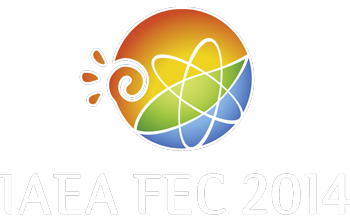Speaker
Mr
William W. Heidbrink
(USA)
Description
Experiments on the DIII-D tokamak show that Alfven eigenmode (AE) activity degrades fast-ion confinement in many high β_N, high q_{min}, steady-state scenario discharges. (β_N is the normalized plasma pressure and q_{min} is the minimum value of the safety factor.) An extensive set of diagnostics measure degraded fast-ion confinement: neutron detectors, fast-ion D_α (FIDA) spectrometers, neutral-particle analyzers, and fast-ion pressure and current profiles inferred from the equilibrium. All fast-ion diagnostics that are sensitive to the co-passing population exhibit reductions relative to classical predictions. The increased fast-ion transport in discharges with strong AE activity accounts quantitatively for the previously observed [1] reduction in global confinement with increasing q_{min}; however, not all high q_{min} discharges show appreciable degradation. In current ramp plasmas, stochastic transport by multiple resonances with many small-amplitude AEs causes “stiff” fast-ion transport; as a result, the achieved fast-ion profile is insensitive to the beam-deposition profile [2]. We postulate that a similar process often occurs in steady-state scenario plasmas. Initial linear stability calculations predict unstable toroidal AEs for these conditions; comparisons with critical-gradient models are underway. If AE degradation of fast-ion confinement can be avoided, modeling indicates that a discharge scenario with q_{min}>2 can provide the MHD stability and bootstrap fraction required for high fusion gain, steady-state operation. The broad current and pressure profiles consistent with elevated qmin enable stable operation at reactor-relevant β_N {\sim -} 5. One-dimensional modeling shows that these conditions are attainable in DIII-D using practical neutral-beam and electron-cyclotron current drive sources and that a self-consistent fully noninductive scenario exists. The challenge in future work is to incorporate calculations of AE-induced transport into the analysis.
This work was supported by the US Department of Energy under SC-G903402 and DE-FC02-04ER54698.
[1] J.R. Ferron, et al., Phys. Plasmas 20, 092504 (2013)
[2] W.W. Heidbrink, et al., Nucl. Fusion 53, 093006 (2013)
| Country or International Organisation | USA |
|---|---|
| Paper Number | EX/10-1 |
Author
Mr
William W. Heidbrink
(USA)

